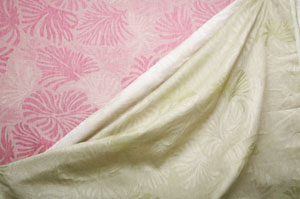Have you ever noticed your eyes a little bloodshot when in a newly decorated hotel room? Have you recently purchased a sofa or installed new drapes in your home, office or baby's nursery? If so, then you may have created a health hazard for your family or co-workers and you most likely caused damage to the environment. Your natural-linen sofa may look like it's undyed and natural, but it will have been in contact with a lot of chemicals. Did you know it takes about 500 gallons of water to produce enough fabric to cover just one sofa? And that the water used can be filled with as much as 20 pounds of chemicals? Or that the fabric on your newly upholstered chairs ends up embedded with chemical residues that may trigger allergic reactions, asthma or more serious health problems as they off-gas into the air for up to a year and are absorbed when you breathe or through your skin? One study says that babies who grow up in newly decorated nurseries have double the asthma and allergy rates of those who don't.
OEcotextiles to the rescue! Their tag line is "Opulent Yet Organic. Sensuous Yet Sustainable." This company, started by two Seattle sisters, is changing the way textiles are made by proving that it's possible to produce luxurious upholstery and drapery fabrics in ways that are non-toxic, ethical and sustainable. After agriculture, the textile industry is the most harmful to the environment in terms of polluting water. More than 2,000 chemicals are used in textile production, with some of the most frequently used known to be very toxic. And the polluted water pollutes nearly everything else. Textile mills discharge millions of litres of contaminated effluent, often at high temperatures, into our rivers, streams and lakes.
OEcotextiles spent 3 years in research and design before achieving its performance, aesthetic and environmental objectives. The result is a collection of fabrics that fulfills commercial requirements, is price competitive with non-green high-end choices and is gorgeous as well as green. Their textiles won the House & Garden trophy for best merchandise at September's Decorex (international textiles exhibition) in London. Interior Design Magazine featured the company's fabrics in its October 2007 edition. OEcotextiles uses a variety of fibers, including linen from Italy, organic cotton from Peru, bamboo from China, hemp from Romania, and abaca from Ecuador, all grown without pesticides or chemical fertilizers. The fibers are spun, milled, woven, dyed and finished without toxic chemicals (often with no chemicals at all) and without using huge amounts of fresh water. Even the dyes are organically certified. O Ecotextiles uses beeswax, aloe vera and vitamin E as fabric softeners eliminating harmful chemical residues in finished products that are absorbed through our skin or lungs.

The total market size for wholesale textile fabric specified by interior designers or architects in just the US and the European Union was $27 billion in 2004. That's a lot of yards of fabric and a lot of environmental damage. A growing segment of this market is demanding textiles that do not off-gas or contain chemicals toxic to human health or which are bad for the earth. The majority of current "green" offerings in interiors textiles are made from recycled polyester. Yet the vast majority of people do not want petroleum derivatives (polyester) in their home or office. They prefer the feel, the drape and the luster of natural fibers. The initial OEcotextiles collection will be eligible to supply points for the LEED (Leadership in Energy & Environmental Design) certification . LEED certification provides independent, third-party verification that a building project is environmentally responsible and a healthy place to live and work. OEcotextiles is targeting those designers and architects who are specifying for LEED buildings (both commercial and residential) including hotels, spas, cruise ships, yachts and private homes.
In addition to their environmental policies, OEcotextiles promotes fair trade and is vehemently anti-sweatshop. They will not source products where practices contravene human rights in the workplace. There is much to be done in this area and perhaps O Ecotextiles will inspire others to help change the way textiles are being made......for our own sake and that of our planet. For more information or to order fabric visit oecotextiles.com 206-633-1177